Facts and statistics about birds are as beautiful as the creatures themselves. They are nature’s wonder that captivates attention with their pretty colors and enchanted songs.
How many bird species are there?
Almost 11,000 different and varied species.
Which is the tallest bird in the world?
The size of the birds varies extensively. African Ostriches are one of the tallest birds and can reach a height of 9 feet. Also, it can run up to a speed of 70 km/h.
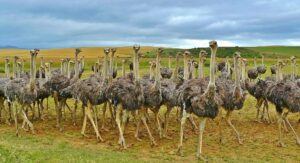
African Ostriches
Which is the smallest bird?
Bee hummingbirds are the smallest birds of all time. It is only two inches long!

Bee Humminbird
How do birds fly?
The answer is not simply because they have wings (and definitely not via intake of Red Bull). The birds’ skeletons are generally very strong but are extremely light. This enables them to take flight.

Birds’ have a varied diet. It often includes a vegetarian diet- nectar, fruits, seeds, and plants. There are also birds who are non-vegetarian such as vultures, who feed on the carcasses of other animals.
Birds like Falcons are predatory and often rely on small animals, including other birds.
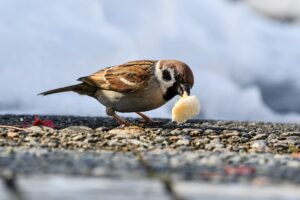
Did you know the fact that birds have no teeth?
Yes, they don’t.
Because birds aren’t blessed with teeth, their digestive system is adapted to process food that is swallowed whole.
Why do birds migrate?
According to the facts in hand, birds try to seek out places that are warm and safe for breeding. Every year many species of birds migrate vast distances.

Birds are definitely social species
Known for their communication through many mediums, birds indeed are social creatures!
Their communication includes- visual signals, calls through different voices and songs (how interesting is that!). They use the mediums when- breeding, hunting, flocking, and attacks from predators such as snakes.
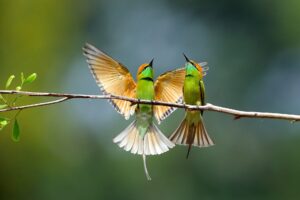
Birds are good parents too!
Similar to tigers, lions, and humans birds are responsible parents too.
The majority of the birds share a long period under their parental care. They stay under the surveillance of their parents right from hatching until they learn how to take their flight. As successful parents, they feed their little ones and teach skills of survival.
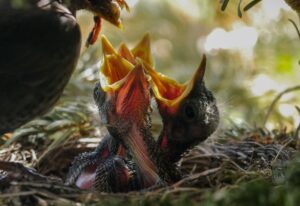
Bird feeding its infants
Let’s consider these ‘oh-so-common’ facts and ‘not-so-common’ statistics about birds
Facts
- Ornithology is the study of birds. People who study them are, ‘Ornithologists’
- The chicken found in the backyard of your house is the most common species of bird.
- Birds usually lay their eggs in a nest except for cuckoo.
- A female cuckoo lays her eggs in different birds’ nests.
- Birds are intelligent! For example, carrion crows in Japan put nuts on the roads and wait for cars to run them over.
- Birds’ species such as crows are often intelligent, as they have seen using tools!
- Bird watching is a fast-growing activity worldwide.
- Bird watching brings about $40 billion and supports 8,60,000 jobs in the US.
Statistics
- 75% of the birds die before 6 months of their existence.
- The noisy woodpecker pecks 20 times per second. That makes 1200 pecks per minute, indeed noisy!
- According to the data, out of 11,000 species nearly are rapidly declining in number.
- In the past 6 decades, almost 70% of seabirds have declined.
- There was a rapid extinction in passenger pigeons’ population as it declined from 2 billion to zero in 40 years.
- The endangered list includes over 2000 birds species.
Endangered and Extinct
Facts and statistics on endangered birds
Endangered… not extinct, but until when?
Recent data states that more than 1400 species of birds fall under the category of endangered. This is almost 14% of the entire bird species.
The list of 12 endangered birds that are at risk of extinction- Kakapo, Fruit Dove, Kiwi, Hooded Grebe, Snowy Owl, Great Curassow, California Condor, African Grey Parrot, Northern Bald Ibis, Ultramarine lorikeets, White Rumpled Vulture, and Regent Honeyeater, etc.
Let’s not only talk about negativity here.
Rescuing of 25 species from the clutches of the endangered category is widely reported. The credit goes to various conservation measures taken by various programs.
For example, the Azores Bullfinch was Europe’s highly endangered bird with a population of 40 in 2005. SPEA (a Portugal bird program) helped the natives to restore forests. Presently, its population is more than 1,000 in number.
Facts and statistics on extinct birds
Extinction isn’t anything new to us... remember dinosaurs?
Extinction has taken a toll on over 159 bird species from 1500 to 2020. A prediction depending on the study of birds states the possibility of a 50% increase in the coming 10 years.
The statistics of extinct birds are as followed- Bonin Grosbeak, Marianne White-eye, Bishop’s Oo, Laysan Honeycreeper, Oahu Akialoa, Lord Howe Gerygone, Pagan Reed-Warbler, and North Island Piopio, etc.
Roles of birds to ecosystem
Facts and statistics about birds that we gathered, state that birds have various roles in the ecosystem.
Birds disperse seeds and transfer nutrients through their migration process. They scavenge on decomposing animals, which prevents the spread of diseases.
Birds eat the unwanted pests from agricultural fields, which prevents the depletion of crops. Helping in the prevention of outbreaks of pests consequently helps in increasing global markets.
Birds are under threat!
In terms of facts, agriculture has the vastest negative impact on birds.
Agriculture has led to 74% of the bird species at the risk of extinction. In North America alone, 290 million acres of grasslands are cleared and turned into agricultural lands. This has led to the displacement of a number of bird species.
Deforestation affects not only soils and forests but also birds.
It has affected 50% of bird species around the world. For instance, in America, deforestation has affected 85% of endangered species, which are now on the verge of extinction.
Also, cats, rats, dogs, and other animals are also responsible for threatening the bird species to extinction. Statistics state that they affect 50% of the birds.
Pollution plays its role in threatening them too!
They devour plastics, both on land and water. Furthermore, pesticides worsen the situation even more. Birds are migratory and both plastics, as well as pesticides, affect them wherever they go.
The illegal trade carried on with Rhinos for their horns and Elephants for their teeth never miss the headlines. The illegal bird trade is equally important and needs headlines too.

Birds are ambassadors of nations
What is a national bird?
A simple answer to this is "an official bird of a particular country is its national bird". Their selection holds on a careful basis. In order to get the title of "a national bird," the bird has to be unique and in abundance.
For example, China: Red-Crowned Crane, India: Peacock, Israel: Hoopoe, Croatia: Nightingale, Singapore: Crimson Sunbird, Japan: Green Pheasant, Belgium: Kestrel, France: Gallic Rooster, etc.
Interesting facts and statistics about birds
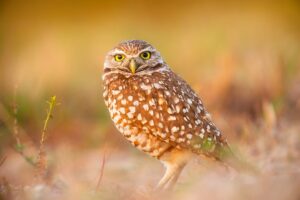
Owl
- Though Owl cannot move its eyes, it rotates its head 270 degrees achieving a vision of 360 degrees.
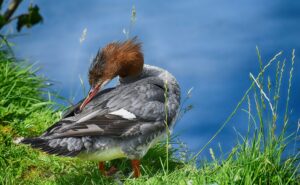
Duck
- A duck’s quack doesn’t echo!

Albatross
- A bird who can sleep while flying. It’s albatross. It dozes off while sailing at 25 mph.

Puffin
- A puffin can fly underwater.

African Grey Parrot
- African Grey Parrot is the most talkative bird in the world. It could say 800 words while other parrots can learn 50.

Penguin
- Penguins can jump as high as 6 feet.
- The Hooded Pitohui is the only poisonous bird known in the world. It has poison in its feathers and skin as well.

Pigeon
- During the world wars, pigeons worked as messengers. Data shows that they were approximately 300,000 in number.
Conclusion
Birds witness one of the best and most beautiful mornings as compared to humans. They are beautiful creatures and their beauty needs security!




